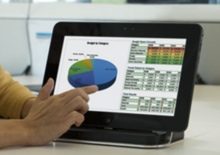Windows 8 expected to trigger growth in touch-enabled notebooks


While it's fair to say that Windows 8 isn't having as smooth a ride as Microsoft might have hoped, it's not all bad news for the operating system, with one research firm is predicting that it will stimulate growth in touch-enabled notebooks.
The research firm in question is NPD DisplaySearch, a part of The NPD Group that provides global market research and consultation focused on the display supply chain. It is predicting a rapid expansion of the touchscreen-enabled notebooks over the course of the year. Last year, the company estimates that touchscreens were present on only 3 percent of notebooks sold, but it expects this number to grow to more than 12 percent during the course of 2013.
For the sake of comparison, NPD data indicates that touchscreens are present on 77 percent of all mobile phones sold, and a 100 percent of tablet PCs sold, which leaves notebooks with plenty of room for expansion.
The primary reason for the growth is being put down to the new notebook form factors that Windows 8, with its focus on touch, has given rise to. Alongside systems featuring the traditional clamshell designs are flip and convertible systems, which NPD say "have been created to attract end users".
And if the predictions turn out to be accurate, it seems like this strategy might well be working.
NPD has broken down the notebook market into five distinct form factors. There are:
Clamshell with track pad, which don't feature a touchscreen display
Clamshell with touchscreen, which sees a touchscreen display fitted to a standard clamshell notebook
Flip design with built-in keyboard, where the system is switched between touch and keyboard modes by changing the device from clamshell to slate
Detachable with bundled docking kit, which is a tablet PC sold with a docking kit
Detachable without keyboard, which is a tablet PC that can be connected to an optional keyboard.
"Touchscreen and PC manufacturers are looking carefully at how successful these initial Windows 8 touchscreen notebook models are in the market, as the touchscreen module requirements for Windows 8 increase module costs, and those requirements are difficult to meet in high volume production," said Calvin Hsieh, research director at NPD DisplaySearch.
But there's a problem — price.
As Hsieh pointed out that "when consumers consider purchasing a notebook computer with touchscreen functionality, the cost of the device is more important than its form factor".
"If prices decline sufficiently, then penetration of touch into the 200 million unit global market and growth in larger screen sizes would drive significant growth for touchscreens in the coming quarters," he said.
Touchscreen capability doesn't come cheap, with the bill of materials for adding a touch module alone coming in at between $50 and $80 for notebooks, with the touch layer on the actual screen adding more to the total cost.
Hsieh suggests that one way to reduce cost would be to opt for structured sensor glass (SSG) rather than the one glass solution (OGS) for notebook touch integration, but that this "may require changes to Windows 8's requirements". Another way to reduce cost would be to do away with the optical bonding process and leave an air gap between the touch sensor and the display, but this reduces the quality of the screen.
While there's little doubt that the PC industry as a whole is stagnating, adding touch to notebooks may have given that market a much-needed — although possibly quite short — sales boost.
Related stories